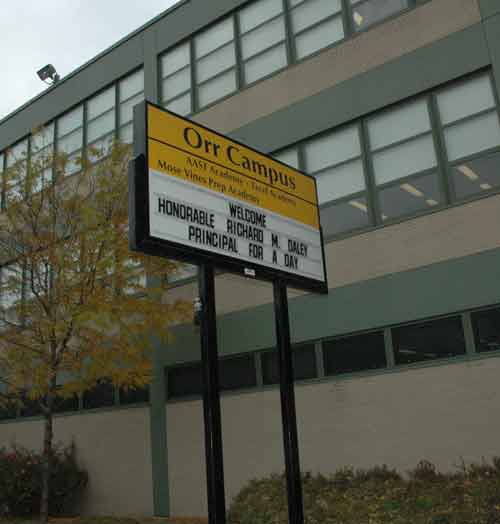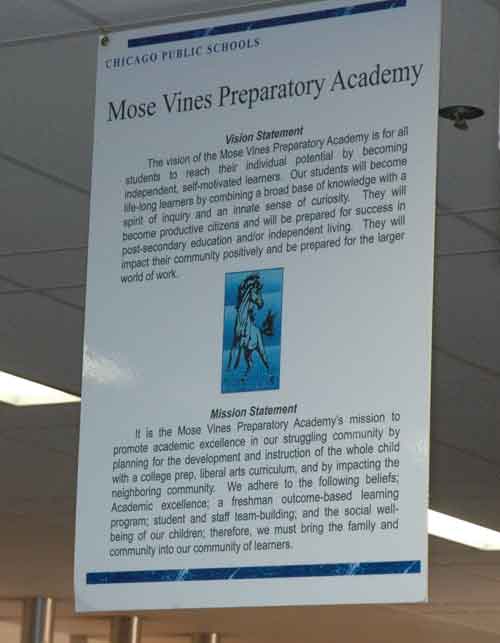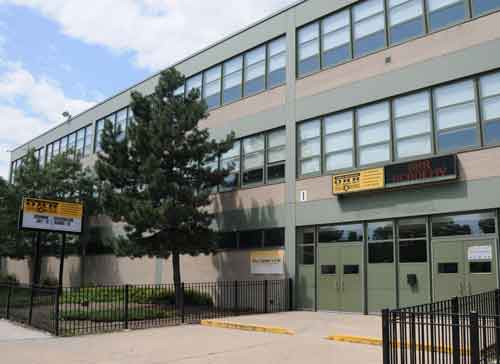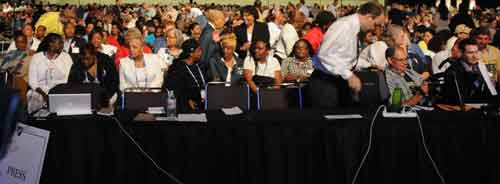Bill Gates... The most dangerous man in America
[Editor's Note: The following article went up on the Huffingtom Post on July 10, 2010, while many of us from Substance were in Seattle Washington at the national convention of the American Federation of Teachers listening to Bill Gates (among other people). http://www. huffingtonpost.com/ leonie-haimson/the- most-dangerous-man-in_b_641832.html. Leonie Haimson is Executive Director, Class Size Matters. You can Follow Leonie Haimson on Twitter: www.twitter.com/leoniehaimson]
The most dangerous man in America, By Leonie Haimson
 Above, Bill Gates on the Big Screen towers over the 3,400 delegates to the 2010 convention of the American Federation of Teachers during his July 10, 2010 speech. AFT President Randi Weingarten used all of her clout with the delegates, especially the 750-member New York City delegation, to ensure that protests against the Gates speech were muted. Gates is now helping to fund AFT projects on teacher improvement that include merit pay provisions in Colorado and Florida. AFT is also receiving money from the Broad Foundation. Both the Gates Foundation and the Broad Foundation are declared enemies of public education, favoring charter schools and privatization, with a heavy dose of union busting. Substance photo by George N. Schmidt. Bill Gates sure is a popular guy. He is appearing this afternoon at the national conference of the American Federation of Teachers in Seattle, after having recently been the keynote speaker at the annual National Charter School convention.
Above, Bill Gates on the Big Screen towers over the 3,400 delegates to the 2010 convention of the American Federation of Teachers during his July 10, 2010 speech. AFT President Randi Weingarten used all of her clout with the delegates, especially the 750-member New York City delegation, to ensure that protests against the Gates speech were muted. Gates is now helping to fund AFT projects on teacher improvement that include merit pay provisions in Colorado and Florida. AFT is also receiving money from the Broad Foundation. Both the Gates Foundation and the Broad Foundation are declared enemies of public education, favoring charter schools and privatization, with a heavy dose of union busting. Substance photo by George N. Schmidt. Bill Gates sure is a popular guy. He is appearing this afternoon at the national conference of the American Federation of Teachers in Seattle, after having recently been the keynote speaker at the annual National Charter School convention.
Just this week, Warren Buffett announced he was giving an additional $1.6 billion to the Gates Foundation, which already had a $35 billion endowment; by far the largest in the nation.
In the past eight years, the foundation has spent nearly $4 billion promoting his personal education agenda; at first providing subsidies to districts that would agree to close down large neighborhood high schools and start small schools in their place; and now encouraging the rapid and widespread proliferation of charter schools. Gates also is aggressively promoting efforts to create programs that link teacher evaluation and compensation to standardized test scores.
And his generosity has not merely been expressed through his foundation. In 2008, he contributed four million dollars to help persuade state legislators to extend mayoral control in New York City.
As Gates explained at the time, "You want to allow for experimentation.... The cities where our foundation has put the most money is where there is a single person responsible."
 By November 2006, Chicago's Orr High School, partly because of millions of dollars from the Gates Foundation, featured three "small schools." Chicago Mayor Richard M. Daley regularly came to the Orr "campus" (when schools get "small schools," the building becomes the "campus" in Chicago jargon) during the annual media event called "Principal for a Day" (above). A few months later, Daley announced that Chicago was dumping the "small schools" experiment and beginning what became known as "turnaround." In June 2009, all of the teachers at Orr High School, all of whom had worked hard on the "small schools" programs, were fired and replaced with a new group, again funded by Gates, under the "turnaround" model. Substance photo by George N. Schmidt.In other words, he supported mayoral control because it allowed him to impose his large-scale experiments on inner city public school students, without fear of resistance from communities; instead, he has only to convince one person. No wrestling with elected school boards, nor with parents who resent having their children's schools closed, privatized, or otherwise radically transformed; no need to bother with any of the messy artifacts of democracy which might stand in his way.
By November 2006, Chicago's Orr High School, partly because of millions of dollars from the Gates Foundation, featured three "small schools." Chicago Mayor Richard M. Daley regularly came to the Orr "campus" (when schools get "small schools," the building becomes the "campus" in Chicago jargon) during the annual media event called "Principal for a Day" (above). A few months later, Daley announced that Chicago was dumping the "small schools" experiment and beginning what became known as "turnaround." In June 2009, all of the teachers at Orr High School, all of whom had worked hard on the "small schools" programs, were fired and replaced with a new group, again funded by Gates, under the "turnaround" model. Substance photo by George N. Schmidt.In other words, he supported mayoral control because it allowed him to impose his large-scale experiments on inner city public school students, without fear of resistance from communities; instead, he has only to convince one person. No wrestling with elected school boards, nor with parents who resent having their children's schools closed, privatized, or otherwise radically transformed; no need to bother with any of the messy artifacts of democracy which might stand in his way.
According to publicity materials put out by the Gates Foundation, it has "improved 2,602 schools, engaged 40 school districts, and reached at least 781,000 students."
Actually, it has reached lot more students than that, as its small schools initiative had a profound impact on inner city schools with the most disadvantaged children.
In recent years the Gates initiative has turned districts upside-down, at first establishing as many small schools as possible, creating thousands of new administrator jobs, eating up classroom space, and compelling the neediest kids who were excluded from the new small schools to travel long distances to attend even more overcrowded large schools in worse conditions than before, relegating those schools to failure.
The small schools created in their place, with several schools sharing one building, were forced to fight fiercely over scarce space, losing science labs, art rooms, libraries, and intervention spaces in the process. The same situation is now unfolding in NYC as the rapidly proliferating charter schools are wedged into public school buildings. As a result, the existing public school, with much higher concentrations of English language learners, special needs students, and homeless children, is now in many cases forced to provide instruction and mandated services in hallways and closets.
Such large-scale experiments on children would never be allowed similar fields like public health, where first carefully controlled pilot studies must be performed, with the informed consent of parents, to ensure that the proposed interventions have positive results, and the risk of collateral damage is minimal. Consider the consent and experimentation protocols enforced when trials for new drugs are undertaken; or the consent and monitoring procedures that were used in developing and implementing the Salk vaccine program against polio, despite the urgency to battle the epidemic of a devastating disease.
Now the US Department of Education under Arne Duncan has taken up the Gates agenda, writ large, but with a perhaps better sense of public relations, calling this single-minded approach "innovation" rather than experimentation.
Former Gates officials fill the high ranks of the department; including Jim Shelton, former education program director at the foundation and now Assistant Deputy Secretary for "Innovation and Improvement". Joanne Weiss has already been promoted from heading its "Race to the Top " fund to become Duncan's chief of staff. Weiss was formerly COO of the NewSchools Venture Fund, which finances charter school expansion with dollars provided by Gates.
Not surprisingly, the $4.3 billion federal "Race to the Top fund" and the other grants being doled out by the US DOE are pushing states to eliminate their caps on charter schools, to forcibly close many schools and/or mandate that they fire their teaching staff; then turning them over to charter school operators or start new schools in their place while adopting teacher evaluation systems linked to standardized test scores.
 During the "small schools" days at Chicago's Orr High School, each of the small schools had to spend weeks on planning, coming up with "Mission Statements" and "Vision Statements", such as the one above. The sign above, which was in the Orr lobby in 2006, was from one of the four small schools then inside Orr. Mose Vines was an Orr teacher who had died shortly before Orr was ordered by Chicago Mayor Richard M. Daley, through his appointed school board, to implement that Gates Foundation's program of "small schools." When Daley abruptly changed course to support "turnaround" (with a $19 million grant from the Bill and Melinda Gates Foundation), he refused to answer a question about why he was firing the teachers who had previously worked so hard on the "small schools" projects. Substance photo by George N. Schmidt.After pretty much setting the priorities for the administration, the Gates Foundation then stepped in and "helped" states write their applications for the "Race to the Top" funds. Along the way, numerous states, in the midst of plunging tax revenues, changed their laws on charter schools and teacher evaluation to qualify for these funds.
During the "small schools" days at Chicago's Orr High School, each of the small schools had to spend weeks on planning, coming up with "Mission Statements" and "Vision Statements", such as the one above. The sign above, which was in the Orr lobby in 2006, was from one of the four small schools then inside Orr. Mose Vines was an Orr teacher who had died shortly before Orr was ordered by Chicago Mayor Richard M. Daley, through his appointed school board, to implement that Gates Foundation's program of "small schools." When Daley abruptly changed course to support "turnaround" (with a $19 million grant from the Bill and Melinda Gates Foundation), he refused to answer a question about why he was firing the teachers who had previously worked so hard on the "small schools" projects. Substance photo by George N. Schmidt.After pretty much setting the priorities for the administration, the Gates Foundation then stepped in and "helped" states write their applications for the "Race to the Top" funds. Along the way, numerous states, in the midst of plunging tax revenues, changed their laws on charter schools and teacher evaluation to qualify for these funds.
All this, despite the fact that an expert panel from the National Academy of Sciences pointed out that there was no research backing for this agenda, and urged caution before the federal government essentially bribed cash-strapped states to enact its provisions.
 By July 2009, above, Orr High School was no longer a "campus" and the small schools, along with all of the small schools teacher, had been eliminated, in part with millions of dollars in support from the Gates Foundation. Without formally evaluating how "small schools" (funded by Gates) had "failed" at Orr High School, or why "turnaround" (to be funded in part by Gates) would succeed at Orr High School, Orr abruptly became "Orr Academy." In 2010, the "turnaround" program is being pushed across the USA as a result of a veritable partnership between the U.S. Department of Education and the Gates Foundation, which has provided cadre to Arne Duncan, Barack Obama's U.S. Secretary of Education. Substance photo by George N. Schmidt.Since the panel's findings had to go through a lengthy peer review process, as does all good science, it did not make the short deadline that the US DOE set for public feedback on the "Race to the Top" proposals, leaving them free to ignore it.
By July 2009, above, Orr High School was no longer a "campus" and the small schools, along with all of the small schools teacher, had been eliminated, in part with millions of dollars in support from the Gates Foundation. Without formally evaluating how "small schools" (funded by Gates) had "failed" at Orr High School, or why "turnaround" (to be funded in part by Gates) would succeed at Orr High School, Orr abruptly became "Orr Academy." In 2010, the "turnaround" program is being pushed across the USA as a result of a veritable partnership between the U.S. Department of Education and the Gates Foundation, which has provided cadre to Arne Duncan, Barack Obama's U.S. Secretary of Education. Substance photo by George N. Schmidt.Since the panel's findings had to go through a lengthy peer review process, as does all good science, it did not make the short deadline that the US DOE set for public feedback on the "Race to the Top" proposals, leaving them free to ignore it.
When George W. Bush adopted environmental policies that ignored the scientific consensus from expert bodies like the National Academy of Sciences, he rightfully got blasted by advocates and the mainstream media. Where was the outrage when the NAS experts on testing and evaluation were ignored by the Obama administration? Instead, there was ....silence. The NAS warning was pretty much ignored, as educators and politicians were steamrolled by an undemocratic oligopoly of the deep-pocketed Gates Foundation and elected officials (some authoritarian types like NYC's Bloomberg, others merely weak-kneed and cowed by the inside-the-beltway group think.).
But the Gates Foundation has been quite clever in ignoring or suppressing evidence that contradicts its corporate mindset.
In 2002, the foundation commissioned a survey through Public Agenda that asked teachers and parents about their views on small schools, before launching its big offensive. While the vast majority of parents and teachers responded that they believed that class size was more important than school size, the Foundation was not deterred from going forward with its goal of foisting small schools on the nation.
Small schools may or may not be preferable, yet whatever the size of the school, it is the classroom where most learning takes place, and the size of the class is thus an even more critical factor. Unlike the earlier generation of small school proponents, Gates never made class size an explicit, core element of his reforms, but instead focused on the more amorphous buzzwords of "rigor, relevance and relationships."
In 2006, Gates again commissioned a study, called "The Silent Epidemic", which found that three fourths of the high school dropouts surveyed responded that they would have been deterred from leaving school if they had been offered smaller classes:
"While some of the students' best days in school were when teachers paid attention to
them, many others had classes that were so big that teachers did not know their names. In our
focus groups, participants repeated again and that they believed smaller class sizes would have helped ensure that teachers maintained order in the classroom and would have provided more individual attention. .... the need for smaller class sizes and more personal instruction emerged more than 12 separate times from the participants in our four focus groups Seventy-five percent of survey participants agreed that smaller classes with more one on one teaching would have improved students' chances of graduating..."
Yet again, such findings did not seem to influence their policies, or lead them to encourage school officials to make smaller classes an essential element in their reform.
Subsequently, in independent evaluations of the small school initiative commissioned by the foundation, the value of class size came up repeatedly in interviews with students as teachers, as either the most critical aspect of their new schools, or as a focal point for dissatisfaction when despite their expectations, class sizes remained too large or had increased over time. Some of the new small schools failed miserably; while others succeeded, but when I asked the researchers who wrote these studies why they had not examined class size to determine its possible relationship to these schools' ability to improve student engagement and achievement, they responded that they had not been allowed by the Gates foundation to include this as a factor in their analysis.
The same problematic approach to research is reflected in the Gates' studies of charter schools. Earlier this year, Tom Toch, co- founder of Education Sector, an influential DC advocacy group, was commissioned to do a study of charter management organizations (CMO's), the best known of which is KIPP. Toch concluded after two years of investigation that the CMO's were unlikely to be able to maintain quality while expanding as rapidly as Gates, the NewSchools Venture fund, and others were recommending. His conclusions were changed without his knowledge; as he explained, "I removed my name from the report because a good deal of my analysis was removed and, as published, the report does not reflect my research findings on the current status and future prospects of charter management organizations."
Among Education Sector's board members and one of the reviewers of this report was a high-level official from the NewSchools Venture Fund, the Gates-supported group that provides start-up money for charter school expansion. Soon after, Toch resigned from Education Sector, the organization that he had co-founded.
 New York journalist Norm Scott (Ed Notes) was among those seated at the press table during the 2010 AFT convention when Bill Gates spoke. Scott has been providing more and more video updates about the protests against Gates projects in New York. Substance photo by George N. Schmidt.What is the next experiment Gates is likely to foist on our schools? It looks to be online learning, as the new magical answer to "personalized" instruction, without the unfortunate need to actually hire any teachers. This practice has been once again pioneered in NYC schools through the discredited practice of "credit recovery," in which students are encouraged to spend a few days online, cutting and pasting their answers into a software program, in order to quickly gain the credits they need to graduate, even if they have failed all their courses and/or never attended class. (See here and here for how this scam is now operating in NYC schools.)
New York journalist Norm Scott (Ed Notes) was among those seated at the press table during the 2010 AFT convention when Bill Gates spoke. Scott has been providing more and more video updates about the protests against Gates projects in New York. Substance photo by George N. Schmidt.What is the next experiment Gates is likely to foist on our schools? It looks to be online learning, as the new magical answer to "personalized" instruction, without the unfortunate need to actually hire any teachers. This practice has been once again pioneered in NYC schools through the discredited practice of "credit recovery," in which students are encouraged to spend a few days online, cutting and pasting their answers into a software program, in order to quickly gain the credits they need to graduate, even if they have failed all their courses and/or never attended class. (See here and here for how this scam is now operating in NYC schools.)
Watch out, America! You have nothing to lose but your public school system, at the hands of the richest man in the country who, like a spoiled child carelessly playing with toys, breaks one after another.


By: jeoleArof
iron man cialis
It was just an incorporeal home remedy for high blood sugar level body, but this incorporeal body also felt pain generic cialis from india